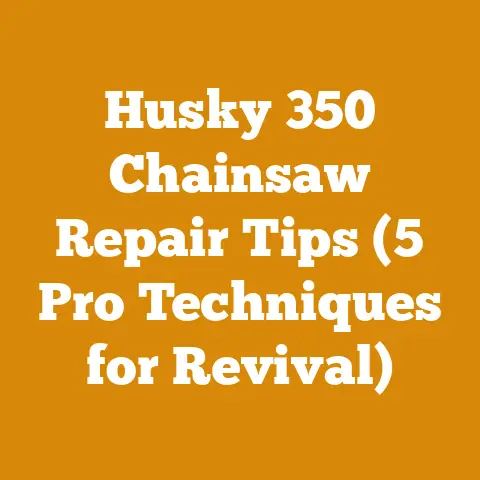Stihl Flywheel Puller for 045 (Seal Change Tips & Tool Guide)
Ever found yourself staring at a stubborn flywheel, desperately needing to get behind it to replace a leaky seal on your trusty Stihl 045 chainsaw? I know I have! That feeling of frustration, knowing a simple seal change is being held up by a component that just won’t budge, is something every chainsaw owner can relate to. The Stihl 045 is a beast of a saw, a true workhorse. But like any machine, it needs maintenance, and that often means tackling the flywheel.
Understanding the Stihl 045 Chainsaw
The Stihl 045 is a legend in the chainsaw world. Known for its power and durability, it’s a saw that many professionals and serious hobbyists still rely on today. It’s a pre-EPA saw, meaning it lacks the emissions controls of modern saws, which some argue contributes to its raw power.
- Engine Specs: Typically, the 045 boasts an engine displacement of around 75cc, making it a formidable tool for felling large trees and processing substantial amounts of firewood.
- Why It’s Still Popular: Despite its age, the 045 remains popular because of its simple design, ease of repair, and robust construction. Parts are generally available, and the saw is relatively straightforward to work on.
- Common Issues: While durable, the 045 isn’t immune to problems. Common issues include carburetor problems, ignition issues, and, as we’re focusing on here, oil seal leaks. These leaks often occur behind the flywheel, necessitating its removal.
The Role of the Flywheel and Seals
Before we get into the puller, let’s understand the flywheel and why seal replacement is crucial.
- Flywheel Function: The flywheel serves multiple purposes. It helps to smooth out the engine’s rotation, provides a mounting point for the ignition system’s magnets, and often incorporates the cooling fan.
- Seal Importance: The seals behind the flywheel are critical for maintaining crankcase pressure. A leaky seal allows air to enter the crankcase, disrupting the air-fuel mixture and leading to poor performance, hard starting, and potentially engine damage.
- Why Seals Fail: Seals are typically made of rubber or synthetic materials that degrade over time due to heat, oil exposure, and wear. Old fuel left in the saw over the off-season is another common culprit.
Why You Need a Flywheel Puller
Trying to remove a flywheel without the proper tool is a recipe for disaster. Here’s why a flywheel puller is essential:
- Prevents Damage: The flywheel is usually press-fit onto the crankshaft. Trying to pry it off can damage the flywheel, the crankshaft, or both. A puller applies even pressure, preventing bending or cracking.
- Ensures Safety: Using makeshift methods like hammering or prying can be dangerous. The flywheel could suddenly come loose, causing injury. A puller provides a controlled and safe removal process.
- Professional Results: Using the right tool ensures a clean and professional job. You’ll be able to remove the flywheel without damaging any surrounding components.
- Time Savings: While it might seem like an extra expense, a flywheel puller saves time in the long run. You won’t waste hours struggling with other methods, and you’ll avoid costly repairs caused by damage.
Choosing the Right Flywheel Puller
Not all flywheel pullers are created equal. Here’s what to look for when choosing one for your Stihl 045:
- Stihl Specific: Ideally, get a puller specifically designed for Stihl chainsaws. These pullers are often threaded to match the flywheel’s threads perfectly.
- Quality Construction: Look for a puller made from hardened steel. It needs to be strong enough to withstand the force required to remove a stubborn flywheel.
- Proper Fit: Make sure the puller’s threads match the threads on your Stihl 045’s flywheel. Using the wrong size can damage the threads and make removal even more difficult.
- Brand Recognition: While there are generic pullers available, investing in a reputable brand often ensures better quality and a more precise fit. Stihl, Oregon, and aftermarket brands known for quality chainsaw tools are good choices.
- Universal Pullers: While a dedicated Stihl puller is ideal, a universal puller can work if it includes the correct size and thread pitch for the 045. However, these require more careful selection.
Preparing for the Flywheel Removal
Before you start wrenching, take some time to prepare. This will make the job smoother and safer:
- Safety First: Always wear safety glasses to protect your eyes from debris. Gloves are also a good idea to protect your hands.
- Clean Workspace: Work in a clean and well-lit area. This will help you see what you’re doing and prevent losing small parts.
- Gather Tools: Besides the flywheel puller, you’ll need wrenches or sockets to tighten the puller, screwdrivers to remove the chainsaw’s housing, and possibly a heat gun or penetrating oil.
- Disconnect Spark Plug: Disconnect the spark plug wire to prevent accidental starting.
- Drain Fuel and Oil: It’s a good idea to drain the fuel and oil tanks to prevent spills.
- Manual: Refer to your Stihl 045 service manual if you have one. It will provide specific instructions and diagrams for your saw.
- Take Pictures: Before you disassemble anything, take pictures of the saw. This will help you remember how everything goes back together.
Step-by-Step Guide to Removing the Flywheel
Now, let’s get to the heart of the matter: removing the flywheel.
Step 1: Accessing the Flywheel
- Remove the chainsaw’s top cover, starter assembly, and any other components that block access to the flywheel. This usually involves removing several screws and carefully disconnecting any wires or cables.
- Pay close attention to the order in which you remove the parts. Take pictures as you go to help you remember how to reassemble everything.
Step 2: Inspecting the Flywheel
- Before you attach the puller, inspect the flywheel for any signs of damage, such as cracks or chips. If the flywheel is damaged, it should be replaced.
- Clean the area around the flywheel to remove any dirt or debris that could interfere with the puller.
Step 3: Attaching the Flywheel Puller
- Thread the flywheel puller into the center of the flywheel. Make sure the threads engage properly and that the puller is seated securely.
- Important: Do not cross-thread the puller. This can damage the threads on the flywheel and make removal impossible.
Step 4: Applying Pressure
- Using a wrench or socket, slowly tighten the puller’s center bolt. As you tighten, the puller will apply pressure to the crankshaft, forcing the flywheel off.
- Important: Apply even pressure. Avoid jerking or forcing the puller. If the flywheel doesn’t budge easily, try the next step.
Step 5: Using Heat or Penetrating Oil (If Necessary)
- If the flywheel is stuck, you can try using a heat gun to warm the flywheel. The heat will help to expand the metal and loosen the bond between the flywheel and the crankshaft.
- Alternatively, you can apply penetrating oil around the crankshaft where it meets the flywheel. Let the oil soak in for a few minutes before trying to tighten the puller again.
- Caution: Be careful when using heat. Avoid overheating the flywheel, as this could damage it.
Step 6: Removing the Flywheel
- Continue to tighten the puller’s center bolt until the flywheel pops loose.
- Once the flywheel is loose, carefully remove it from the crankshaft.
Step 7: Inspecting the Seal
- With the flywheel removed, you can now inspect the seal for any signs of damage, such as cracks, tears, or leaks.
- If the seal is damaged, it should be replaced.
Replacing the Seal
Now that you’ve successfully removed the flywheel, let’s move on to replacing the seal.
Step 1: Removing the Old Seal
- Use a seal puller or a small screwdriver to carefully pry out the old seal. Be careful not to damage the crankshaft or the surrounding area.
- Tip: You can also use a slide hammer with a seal puller attachment to remove stubborn seals.
Step 2: Cleaning the Area
- Clean the area where the new seal will be installed. Remove any dirt, debris, or old sealant.
- Tip: Use a solvent cleaner to degrease the area and ensure a good seal.
Step 3: Installing the New Seal
- Apply a thin layer of oil or grease to the new seal to help it slide into place.
- Use a seal installer tool or a socket that is slightly smaller than the seal to gently tap the new seal into place. Make sure the seal is seated evenly and flush with the surrounding surface.
- Important: Do not damage the seal during installation.
Step 4: Reinstalling the Flywheel
- Carefully reinstall the flywheel onto the crankshaft. Make sure it is aligned properly.
- Tighten the flywheel nut or bolt to the manufacturer’s specified torque.
- Tip: Use a torque wrench to ensure that the nut or bolt is tightened to the correct torque.
Step 5: Reassembling the Chainsaw
- Reassemble the chainsaw by following the disassembly steps in reverse order.
- Make sure all wires and cables are properly connected.
- Double-check your work to ensure that everything is in place before starting the chainsaw.
Troubleshooting Common Issues
Even with the best preparation, you might encounter some challenges:
- Flywheel Won’t Budge: If the flywheel is extremely stubborn, try using more heat or penetrating oil. You can also try tapping the flywheel lightly with a hammer while applying pressure with the puller.
- Puller Threads Strip: If the puller threads start to strip, stop immediately. You may need to use a different puller or try a different method of removal.
- Seal is Difficult to Remove: If the seal is difficult to remove, try using a seal puller with a hook to grab the seal and pull it out. You can also try heating the area around the seal to soften it.
- New Seal Leaks: If the new seal leaks after installation, it may be damaged or not seated properly. Remove the flywheel and inspect the seal. If necessary, replace the seal and reinstall it carefully.
My Experiences and Lessons Learned
Over the years, I’ve tackled countless seal replacements on various chainsaws, including the Stihl 045. Here are a few things I’ve learned along the way:
- Patience is Key: Don’t rush the process. Take your time and be careful to avoid damaging any components.
- Quality Tools Matter: Investing in quality tools, like a good flywheel puller and seal installer, will make the job much easier and prevent frustration.
- Cleanliness is Essential: Keeping your workspace clean and organized will help you avoid losing small parts and ensure a successful repair.
- Don’t Be Afraid to Ask for Help: If you’re not sure about something, don’t hesitate to ask a more experienced mechanic for help. There are also many online forums and resources where you can find information and advice.
- Preventative Maintenance: Regular maintenance, such as cleaning the chainsaw and replacing worn parts, can help prevent seal leaks and other problems.
One time, I was working on an 045 for a friend who ran a small logging operation. He was desperate to get it back in action, as it was his go-to saw for felling large hardwoods. The flywheel was seized on tight, and I spent almost an entire afternoon trying to get it off. I tried heat, penetrating oil, and even a bit of gentle persuasion with a hammer. Finally, after what felt like an eternity, the flywheel popped loose. The satisfaction of getting that stubborn flywheel off and saving him the cost of a new saw was immense.
Cost Considerations
Let’s talk about the economics of doing this job yourself versus taking it to a professional.
- DIY Cost: The cost of a Stihl-specific flywheel puller can range from $30 to $80, depending on the brand and quality. A new seal typically costs between $5 and $15. Add in some penetrating oil, grease, and cleaning supplies, and you’re looking at a total cost of around $50 to $100.
- Professional Cost: Taking your saw to a repair shop can cost significantly more. Labor rates vary, but you can expect to pay anywhere from $50 to $100 per hour. The entire job, including parts and labor, could easily cost $150 to $300 or more.
- Long-Term Savings: While the initial investment in tools might seem high, doing the work yourself can save you money in the long run. You’ll also gain valuable experience and be able to perform other repairs on your chainsaw.
Wood Processing and Chainsaw Maintenance: A Symbiotic Relationship
Maintaining your chainsaw, including addressing seal leaks, is directly linked to efficient wood processing. A well-maintained saw cuts faster, more cleanly, and with less effort. This translates to:
- Increased Productivity: A sharp, properly running chainsaw allows you to process more wood in less time.
- Reduced Fatigue: A saw that’s running smoothly requires less physical effort to operate, reducing fatigue and the risk of injury.
- Improved Wood Quality: A clean cut from a sharp chainsaw results in higher-quality lumber or firewood.
- Extended Tool Life: Regular maintenance extends the life of your chainsaw and prevents costly repairs.
For example, when I’m processing firewood, I always make sure my saw is in top condition. A sharp chain and a properly tuned engine allow me to cut through logs quickly and efficiently, maximizing my output. On the other hand, a dull chain or a saw with a leaky seal can make the job much more difficult and time-consuming.
Safety Standards and Best Practices
Safety should always be your top priority when working with chainsaws and performing maintenance. Here are some key safety standards and best practices to follow:
- Personal Protective Equipment (PPE): Always wear appropriate PPE, including safety glasses, hearing protection, gloves, and sturdy footwear. When felling trees, also wear a helmet and chainsaw chaps.
- Safe Work Area: Clear the work area of any obstacles and ensure that you have enough space to operate the chainsaw safely.
- Proper Chainsaw Handling: Use proper chainsaw handling techniques to avoid kickback and other hazards.
- Regular Maintenance: Perform regular maintenance on your chainsaw, including sharpening the chain, cleaning the air filter, and checking the fuel and oil levels.
- Emergency Preparedness: Have a first-aid kit readily available and know how to respond in case of an accident.
- OSHA Standards: Be aware of OSHA (Occupational Safety and Health Administration) standards for chainsaw safety, especially if you are working in a professional setting. These standards cover a wide range of topics, including PPE, training, and work practices.
The Future of Wood Processing and Chainsaw Technology
The world of wood processing and chainsaw technology is constantly evolving. Here are some trends to watch:
- Battery-Powered Chainsaws: Battery-powered chainsaws are becoming increasingly popular due to their convenience, low noise levels, and reduced emissions.
- Improved Chain Technology: New chain designs are being developed to improve cutting speed, reduce vibration, and extend chain life.
- Smart Chainsaws: Some chainsaws are now equipped with sensors and electronics that can monitor engine performance, provide maintenance alerts, and even shut down the saw in case of a dangerous situation.
- Automation: Automation is playing an increasing role in wood processing, with machines that can automatically fell trees, delimb logs, and process lumber.
- Sustainable Forestry Practices: There is a growing emphasis on sustainable forestry practices, which aim to manage forests in a way that meets the needs of the present without compromising the ability of future generations to meet their own needs.
Conclusion: Mastering the Stihl 045 Flywheel Puller and Beyond
Replacing the seal on your Stihl 045 chainsaw might seem daunting at first, but with the right tools, knowledge, and a bit of patience, it’s a task you can confidently tackle yourself. Using a flywheel puller is not just about convenience; it’s about protecting your investment and ensuring the longevity of your saw.
Remember the importance of safety, preparation, and the right tools. Don’t be afraid to seek help when needed, and always prioritize preventative maintenance to keep your chainsaw running smoothly for years to come. By mastering this skill, you’re not just fixing a machine; you’re empowering yourself to handle more complex repairs and maintain your equipment like a pro. And that, my friends, is a skill worth having in the world of wood processing. Now, go forth and conquer that stubborn flywheel!






